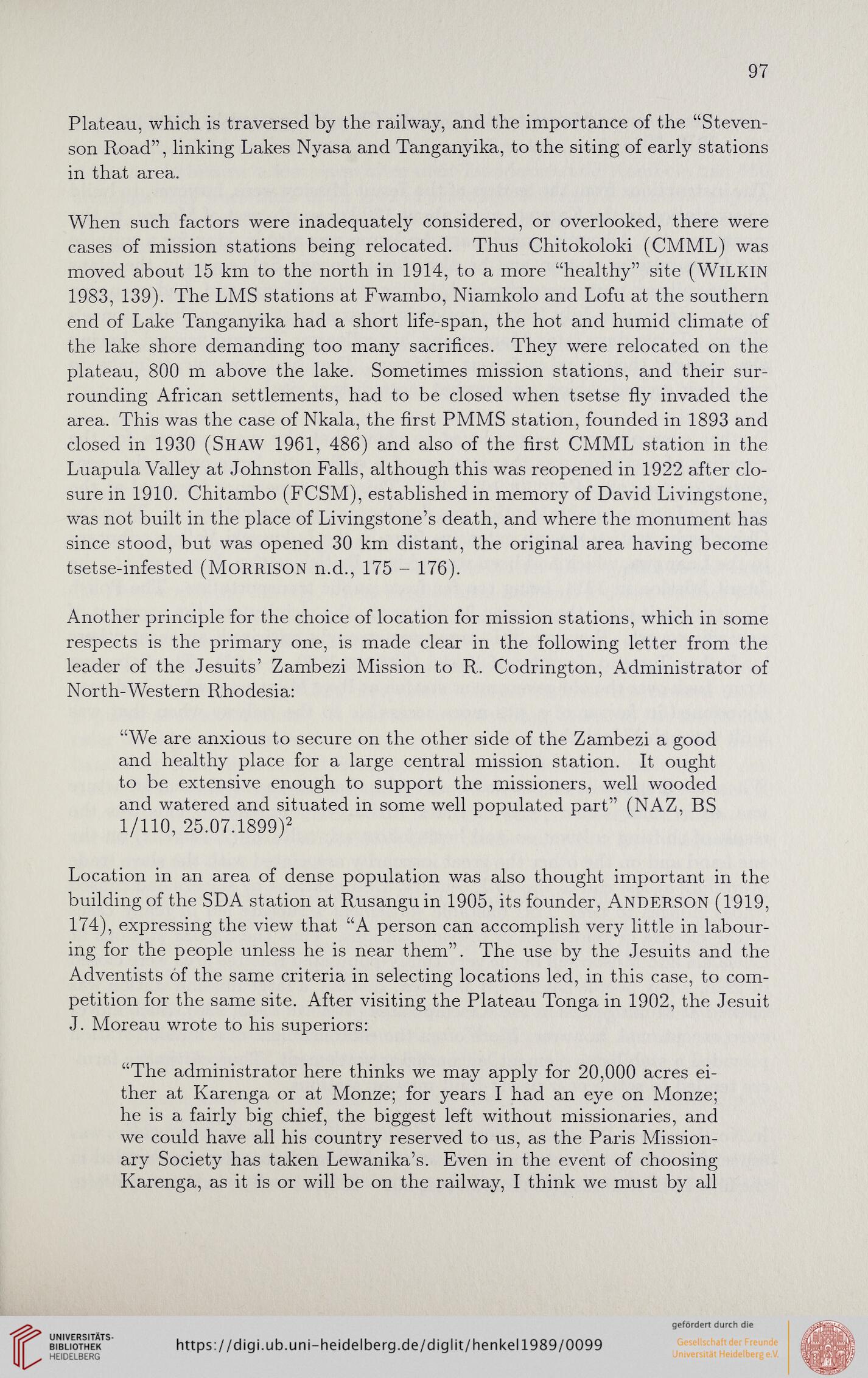97
Plateau, which is traversed by the railway, and the importance of the “Steven-
son Road”, linking Lakes Nyasa and Tanganyika, to the siting of early stations
in that area.
When such factors were inadequately considered, or overlooked, there were
cases of mission stations being relocated. Thus Chitokoloki (CMML) was
moved about 15 km to the north in 1914, to a more “healthy” site (WlLKIN
1983, 139). The LMS stations at Fwambo, Niamkolo and Lofu at the southern
end of Lake Tanganyika had a short life-span, the hot and humid climate of
the lake shore demanding too many sacrifices. They were relocated on the
plateau, 800 m above the lake. Sometimes mission stations, and their sur-
rounding African settlements, had to be closed when tsetse fly invaded the
area. This was the case of Nkala, the first PMMS station, founded in 1893 and
closed in 1930 (Shaw 1961, 486) and also of the first CMML station in the
Luapula Valley at Johnston Falls, although this was reopened in 1922 after clo-
sure in 1910. Chitambo (FCSM), established in memory of David Livingstone,
was not built in the place of Livingstone’s death, and where the monument has
since stood, but was opened 30 km distant, the original area having become
tsetse-infested (MORRISON n.d., 175 - 176).
Another principle for the choice of location for mission stations, which in some
respects is the primary one, is made clear in the following letter from the
leader of the Jesuits’ Zambezi Mission to R. Codrington, Administrator of
North-Western Rhodesia:
“We are anxious to secure on the other side of the Zambezi a good
and healthy place for a large central mission station. It ought
to be extensive enough to support the missioners, well wooded
and watered and situated in some well populated part” (NAZ, BS
1/110, 25.07.1899)2
Location in an area of dense population was also thought important in the
building of the SDA station at Rusanguin 1905, its founder, ANDERSON (1919,
174), expressing the view that “A person can accomplish very little in labour-
ing for the people unless he is near them”. The use by the Jesuits and the
Adventists of the same criteria in selecting locations led, in this case, to com-
petition for the same site. After visiting the Plateau Tonga in 1902, the Jesuit
J. Moreau wrote to his superiors:
“The administrator here thinks we may apply for 20,000 acres ei-
ther at Karenga or at Monze; for years I had an eye on Monze;
he is a fairly big chief, the biggest left without missionaries, and
we could have all his country reserved to us, as the Paris Mission-
ary Society has taken Lewanika’s. Even in the event of choosing
Karenga, as it is or will be on the railway, I think we must by all
Plateau, which is traversed by the railway, and the importance of the “Steven-
son Road”, linking Lakes Nyasa and Tanganyika, to the siting of early stations
in that area.
When such factors were inadequately considered, or overlooked, there were
cases of mission stations being relocated. Thus Chitokoloki (CMML) was
moved about 15 km to the north in 1914, to a more “healthy” site (WlLKIN
1983, 139). The LMS stations at Fwambo, Niamkolo and Lofu at the southern
end of Lake Tanganyika had a short life-span, the hot and humid climate of
the lake shore demanding too many sacrifices. They were relocated on the
plateau, 800 m above the lake. Sometimes mission stations, and their sur-
rounding African settlements, had to be closed when tsetse fly invaded the
area. This was the case of Nkala, the first PMMS station, founded in 1893 and
closed in 1930 (Shaw 1961, 486) and also of the first CMML station in the
Luapula Valley at Johnston Falls, although this was reopened in 1922 after clo-
sure in 1910. Chitambo (FCSM), established in memory of David Livingstone,
was not built in the place of Livingstone’s death, and where the monument has
since stood, but was opened 30 km distant, the original area having become
tsetse-infested (MORRISON n.d., 175 - 176).
Another principle for the choice of location for mission stations, which in some
respects is the primary one, is made clear in the following letter from the
leader of the Jesuits’ Zambezi Mission to R. Codrington, Administrator of
North-Western Rhodesia:
“We are anxious to secure on the other side of the Zambezi a good
and healthy place for a large central mission station. It ought
to be extensive enough to support the missioners, well wooded
and watered and situated in some well populated part” (NAZ, BS
1/110, 25.07.1899)2
Location in an area of dense population was also thought important in the
building of the SDA station at Rusanguin 1905, its founder, ANDERSON (1919,
174), expressing the view that “A person can accomplish very little in labour-
ing for the people unless he is near them”. The use by the Jesuits and the
Adventists of the same criteria in selecting locations led, in this case, to com-
petition for the same site. After visiting the Plateau Tonga in 1902, the Jesuit
J. Moreau wrote to his superiors:
“The administrator here thinks we may apply for 20,000 acres ei-
ther at Karenga or at Monze; for years I had an eye on Monze;
he is a fairly big chief, the biggest left without missionaries, and
we could have all his country reserved to us, as the Paris Mission-
ary Society has taken Lewanika’s. Even in the event of choosing
Karenga, as it is or will be on the railway, I think we must by all




